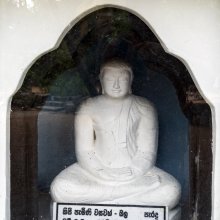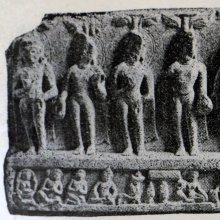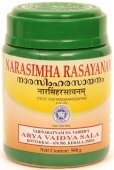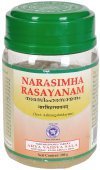Shikhi, Sikhī, Śikhi, Sikhi, Śikhī: 22 definitions
Introduction:
Shikhi means something in Buddhism, Pali, Hinduism, Sanskrit, Marathi, Hindi, biology. If you want to know the exact meaning, history, etymology or English translation of this term then check out the descriptions on this page. Add your comment or reference to a book if you want to contribute to this summary article.
The Sanskrit terms Śikhi and Śikhī can be transliterated into English as Sikhi or Shikhi, using the IAST transliteration scheme (?).
Images (photo gallery)
In Hinduism
Ayurveda (science of life)
Nighantu (Synonyms and Characteristics of Drugs and technical terms)
Source: WorldCat: Rāj nighaṇṭu1) Śikhī (शिखी) is another name for Śitāvarī, an unidentified medicinal plant, according to verse 4.50-52 of the 13th-century Raj Nighantu or Rājanighaṇṭu. The fourth chapter (śatāhvādi-varga) of this book enumerates eighty varieties of small plants (pṛthu-kṣupa). Note: Dr. J.K. Ojhā identifies Śitāvarī as Celosia argentea Linn (“plumed cockscomb”; of the Amaranthaceae family) while the commentator of the Rājanighaṇṭu identifies it with Blepharis edulis Pers (“uttanjan”; from the Acanthaceae family); both are quite apart from each other. Together with the names Śikhī and Śitāvarī, there are a total of fifteen Sanskrit synonyms identified for this plant.
2) Śikhī (शिखी) is also mentioned as another name for Citraka, a medicinal plant identified with (1) [white variety] Plumbago zeylanica Linn.; (2) [red variety] Plumbago rosea Linn. syn. or Plumbago indica Linn., both from the Plumbaginaceae or “leadwort” family of flowering plants, according to verse 6.43-45.—The sixth chapter (pippalyādi-varga) of this book enumerates ninety-five varieties of plants obtained from the market (paṇyauṣadhi). Together with the names Śikhī and Citraka, there are a total of twenty Sanskrit synonyms identified for this plant.
Toxicology (Study and Treatment of poison)
Source: Shodhganga: Kasyapa Samhita—Text on Visha ChikitsaŚikhi (शिखि) refers to the “peacock” and is mentioned as one of the sworn enemies of Snakes (Sarpas), as taught in the Kāśyapa Saṃhitā: an ancient Sanskrit text from the Pāñcarātra tradition dealing with both Tantra and Viṣacikitsā—an important topic from Āyurveda which deals with the study of Toxicology (Agadatantra or Sarpavidyā).—The Kāśyapasaṃhitā (verse IV.33) talks about the sworn enemies of Sarpas (snakes): Boar, lightning, peacock (śikhi), eagle, cat, mongoose and wolf are its sworn enemies.
Unclassified Ayurveda definitions
Source: Wisdom Library: Āyurveda and botanyŚikhi (शिखि):—Another name for Barhi, which is a Sanskrit word referring to the “peacock”. The meat of this animal is part of the māṃsavarga (‘group of flesh’), which is used throughout Ayurvedic literature.
Source: gurumukhi.ru: Ayurveda glossary of termsŚikhi (शिखि):—Wood charcoal

Āyurveda (आयुर्वेद, ayurveda) is a branch of Indian science dealing with medicine, herbalism, taxology, anatomy, surgery, alchemy and related topics. Traditional practice of Āyurveda in ancient India dates back to at least the first millenium BC. Literature is commonly written in Sanskrit using various poetic metres.
Purana and Itihasa (epic history)
Source: archive.org: Puranic EncyclopediaŚikhī (शिखी).—A nāga born in the Kaśyapa dynasty. (Udyoga Parva, Chapter 103, Verse 12).
Source: Cologne Digital Sanskrit Dictionaries: The Purana Index1a) Śikhī (शिखी).—One of the gods worshipped in housebuilding.*
- * Matsya-purāṇa 253. 24.
1b) R. a chief river of Plakṣadvīpa.*
- * Viṣṇu-purāṇa II. 4. 11.
Śikhī (शिखी) is a name mentioned in the Mahābhārata (cf. V.101.12/V.103) and represents one of the many proper names used for people and places. Note: The Mahābhārata (mentioning Śikhī) is a Sanskrit epic poem consisting of 100,000 ślokas (metrical verses) and is over 2000 years old.

The Purana (पुराण, purāṇas) refers to Sanskrit literature preserving ancient India’s vast cultural history, including historical legends, religious ceremonies, various arts and sciences. The eighteen mahapuranas total over 400,000 shlokas (metrical couplets) and date to at least several centuries BCE.
Dharmashastra (religious law)
Source: Prācyā: Animals and animal products as reflected in Smṛti textsŚikhi (शिखि) or Mayūra refers to the bird “Peacock” (Pavo cristatus).—Birds have been described in several ancient Sanskrit texts that they have been treated elaborately by eminent scholars. These birds [viz., Śikhi] are enumerated in almost several Smṛtis in context of specifying the expiations for killing them and their flesh being used as a dietary article to give satisfaction to the manes (Pitṛs) in Śrāddha rites. These are elaborated especially in the Manusmṛti, Parāśarasmṛti [chapter VI], Gautamasmṛti [chapter 23], Śātātapasmṛti [II.54-56], Uśānasmṛti [IX.10-IX.12], Yājñavalkyasmṛti [I.172-I.175], Viṣṇusmṛti [51.28-51.29], Uttarāṅgirasasmṛti [X.16].

Dharmashastra (धर्मशास्त्र, dharmaśāstra) contains the instructions (shastra) regarding religious conduct of livelihood (dharma), ceremonies, jurisprudence (study of law) and more. It is categorized as smriti, an important and authoritative selection of books dealing with the Hindu lifestyle.
Jyotisha (astronomy and astrology)
Source: Wisdom Library: Brihat Samhita by VarahamihiraŚikhi (शिखि) refers to “fire”, according to the Bṛhatsaṃhitā (chapter 5), an encyclopedic Sanskrit work written by Varāhamihira mainly focusing on the science of ancient Indian astronomy astronomy (Jyotiṣa).—Accordingly, “If there should be both lunar and solar eclipses in one month, princes will suffer both from dissensions among their own army and from wars. [...] If Mercury should see the eclipsed disc, honey and oil will become scarce; princes will suffer. If Mars should see the eclipsed disc, there will be war in the land and fear from fire [i.e., śikhi-kopa] and robbers. If Venus should see the eclipsed disc, crops will be injured and there will be drought and famine in the land and the mankind will have fear from robbers”.

Jyotisha (ज्योतिष, jyotiṣa or jyotish) refers to ‘astronomy’ or “Vedic astrology” and represents the fifth of the six Vedangas (additional sciences to be studied along with the Vedas). Jyotisha concerns itself with the study and prediction of the movements of celestial bodies, in order to calculate the auspicious time for rituals and ceremonies.
General definition (in Hinduism)
Source: Wisdom Library: HinduismŚikhi (शिखि, “fire”):—Third of the six seats of the Svādhiṣṭhāna (2nd chakra). It is identified with the third of the seven worlds, named svarloka. Together, these seven seatsthey form the Brahmāṇḍa (cosmic egg). The Randhra seat points to the south-east. This seat is also known as Vahni (वह्नि).
In Buddhism
Theravada (major branch of Buddhism)
Source: Pali Kanon: Pali Proper NamesSikhi. The twentieth of the twenty four Buddhas.
He was born in the Nisabha pleasance in Arunavati, his father being the khattiya Aruna (Arunava) and his mother Pabhavati. He was so named because his unhisa stood up like a flame (sikha). For seven thousand years he lived in the household in three palaces - Sucanda, Giri, Vahana (BuA.p.201 calls them Sucanda kasiri, Giriyasa and Narivasabha) - his wife being Sabbakama and his son Atula. He left home on an elephant, practised austerities for eight months, was given milk rice by the daughter of Piyadassi setthi of Sudassananigama, and grass for his seat by Anomadassi. His Bodhi was a pundarika. His first sermon was preached in the Migacira pleasaunce near Arunavati, and his Twin Miracle was performed near Suriyavati under a campaka tree.The Bodhisatta was Arindama, king of Paribhutta. Abhibhu and Sambhava were his chief disciples among monks, and Akhila (Makhila) and Paduma among nuns.
His constant attendant was Khemankara. Among his patrons were Sirivaddha and Canda (Nanda) among men, and Citta and Sugutta among women. His body was sixty cubits high, and he lived to the age of seventy thousand years, dying in Dussarama (Assarama) in Silavati. Over his relics was erected a thupa three leagues in height(Bu.xxi.; BuA.201ff.; cf. D.ii.7; iii.195f.; J.i.41, 94; DhA.i.69; S.ii.9; Dvy.333).
Sikhi Buddha held the Patimokkha ceremony only once in six years (DhA.iii.236; cf. Sp.i.191).
For a visit paid by him to the Brahma world see Abhibhu. His name also occurs in the Arunavati Paritta (q.v.).
Sikhi Sutta. The process by which Sikhi Buddha, like the other Buddhas, reached Enlightenment. S.iii.9.
Theravāda is a major branch of Buddhism having the the Pali canon (tipitaka) as their canonical literature, which includes the vinaya-pitaka (monastic rules), the sutta-pitaka (Buddhist sermons) and the abhidhamma-pitaka (philosophy and psychology).
Tibetan Buddhism (Vajrayana or tantric Buddhism)
Source: archive.org: The Indian Buddhist IconographyŚikhī (शिखी) (or Śikhīn) refers to one of the seven mortal Buddhas (mānuṣī) whose names appear last in the list of thirty-two Buddhas in Mahāyāna Buddhism.—The last seven Tathāgatas are well-known, and are designated by the Mahāyānist as Mānuṣī or “Mortal Buddhas”. When represented, the last seven Mortal Buddhas appear all alike; they are of one colour and one form, usually sitting cross-legged,with the right hand disposed in the Bhūmisparśa-mudrā (earth-touching attitute), which is the mudrā peculiar to Akṣobhya. [...] In paintings, the Mortal Buddhas [viz., Śikhī] have usually a yellow or golden complexion. [...] Sometimes they are represented as standing, in which case the appear under a distinguishing Bodhi Tree and with a distinguishing mudrā.
Śikhī is associated with the (Mortal) Buddhaśakti named Śikhimālinī, and together they bring into existence the (Mortal) Bodhisattva named Ratnadhara.

Tibetan Buddhism includes schools such as Nyingma, Kadampa, Kagyu and Gelug. Their primary canon of literature is divided in two broad categories: The Kangyur, which consists of Buddha’s words, and the Tengyur, which includes commentaries from various sources. Esotericism and tantra techniques (vajrayāna) are collected indepently.
General definition (in Buddhism)
Source: Wisdom Library: Dharma-samgrahaŚikhī (शिखी) refers to the second of the “seven Buddhas” (saptatathāgata) as defined in the Dharma-saṃgraha (section 6). The Dharma-samgraha (Dharmasangraha) is an extensive glossary of Buddhist technical terms in Sanskrit (e.g., saptatathāgata and Śikhī). The work is attributed to Nagarguna who lived around the 2nd century A.D.
Biology (plants and animals)
Source: Google Books: CRC World Dictionary (Regional names)Sikhi in India is the name of a plant defined with Plumbago zeylanica in various botanical sources. This page contains potential references in Ayurveda, modern medicine, and other folk traditions or local practices It has the synonym Plumbago zeylanica var. glaucescens Boiss. (among others).
Example references for further research on medicinal uses or toxicity (see latin names for full list):
· Flora of Tropical East Africa, Plumbaginaceae (1976)
· Prodr. Fl. SW. Afr. (1967)
· Monographs in Systematic Botany from the Missouri Botanical Garden (1985)
· Species Plantarum (1753)
· Species Plantarum (1762)
· Flora of Southern Africa (1963)
If you are looking for specific details regarding Sikhi, for example extract dosage, health benefits, chemical composition, side effects, pregnancy safety, diet and recipes, have a look at these references.

This sections includes definitions from the five kingdoms of living things: Animals, Plants, Fungi, Protists and Monera. It will include both the official binomial nomenclature (scientific names usually in Latin) as well as regional spellings and variants.
Languages of India and abroad
Pali-English dictionary
Source: BuddhaSasana: Concise Pali-English Dictionarysikhī : (m.) fire; peacock.

Pali is the language of the Tipiṭaka, which is the sacred canon of Theravāda Buddhism and contains much of the Buddha’s speech. Closeley related to Sanskrit, both languages are used interchangeably between religions.
Marathi-English dictionary
Source: DDSA: The Molesworth Marathi and English Dictionaryśikhī (शिखी).—m S (Poetry.) Fire. Ex. śikhī jasā vēṇu- vanīñca pēṭē || gāṛhāniyāñcē uṭhatī capēṭē ||. 2 A peacock: and śikhinī f A pea-hen.
--- OR ---
śikhī (शिखी).—a S Crested;--as a bird: also peaked;--as a mountain.
Source: DDSA: The Aryabhusan school dictionary, Marathi-Englishśikhī (शिखी).—m A peacock. Fire. a Crested. Peaked.
Marathi is an Indo-European language having over 70 million native speakers people in (predominantly) Maharashtra India. Marathi, like many other Indo-Aryan languages, evolved from early forms of Prakrit, which itself is a subset of Sanskrit, one of the most ancient languages of the world.
Sanskrit dictionary
Source: Cologne Digital Sanskrit Dictionaries: Edgerton Buddhist Hybrid Sanskrit DictionaryŚikhī (शिखी).—name of a kind of magic: Divyāvadāna 636.26 (verse, in a list of names of vidyā).
Source: Cologne Digital Sanskrit Dictionaries: Monier-Williams Sanskrit-English Dictionary1) Śikhī (शिखी):—[from śikha] a f. a kind of magic, [Divyāvadāna]
2) [v.s. ...] Name of a river, [Viṣṇu-purāṇa]
3) Śikhi (शिखि):—[from śikhā] 1. śikhi m. (mc. for śikhin) a peacock, [Harivaṃśa]
4) [v.s. ...] Name of Indra under Manu Tāmasa, [Mārkaṇḍeya-purāṇa]
5) [v.s. ...] the god of love, [cf. Lexicographers, esp. such as amarasiṃha, halāyudha, hemacandra, etc.]
6) [v.s. ...] 2. śikhi in [compound] for śikhin.
7) Śikhī (शिखी):—b See śikha, p. 1070, col. 2.
[Sanskrit to German]
Sanskrit, also spelled संस्कृतम् (saṃskṛtam), is an ancient language of India commonly seen as the grandmother of the Indo-European language family (even English!). Closely allied with Prakrit and Pali, Sanskrit is more exhaustive in both grammar and terms and has the most extensive collection of literature in the world, greatly surpassing its sister-languages Greek and Latin.
Hindi dictionary
Source: DDSA: A practical Hindi-English dictionaryŚikhī (शिखी):—(nm) a peacock.
...
Kannada-English dictionary
Source: Alar: Kannada-English corpusŚikhi (ಶಿಖಿ):—
1) [adjective] having a pointed top.
2) [adjective] having a tuft of hair on the crown of the head.
--- OR ---
Śikhi (ಶಿಖಿ):—
1) [noun] a tuft of hair on the crown of the head.
2) [noun] a peacock.
3) [noun] fire (burning with flames).
4) [noun] a tree (in gen.).
5) [noun] the plant Trigonella foenum-graceum of Papilionaceae family; fenugreek.
6) [noun] the plant Carpopogon pruriens.
7) [noun] a brāhmaṇa.
8) [noun] Kētu, one of the nine astrological plant.
9) [noun] the planet Mars.
10) [noun] a comet.
11) [noun] copper.
12) [noun] the top of a tree.
13) [noun] the head.
14) [noun] a protective, metal covering for the head; a helmet.
15) [noun] the black, poisonous cobra, Naga tripudians, found in India and Africa; Naja naja Hanna.
16) [noun] any medicinal plant.
17) [noun] fire caused by a thunder.
18) [noun] (math.) a symbol for the number three.
19) [noun] (pros.) a metrical foot consisting of one long followed by a short and a long syllabic instants(-u-); amphimacer.
Kannada is a Dravidian language (as opposed to the Indo-European language family) mainly spoken in the southwestern region of India.
See also (Relevant definitions)
Starts with (+37): Shikhibala, Shikhibhaya, Shikhibhu, Shikhibuddha, Shikhidhvaja, Shikhidhvajatirtha, Shikhidish, Shikhidyut, Shikhigala, Shikhigraha, Shikhigriva, Shikhikana, Shikhikantha, Shikhikopa, Shikhimala, Shikhimalini, Shikhimandal, Shikhimandala, Shikhimoda, Shikhimrityu.
Ends with: Avabhasanashikhin, Badabashikhi, Davashikhi, Drigushikhi, Makhashikhi, Mayoora shikhi, Mayura shikhi, Mayurashikhi, Ropashikhi, Tagarasikhi, Tamrashikhi, Trishikhi, Udarashikhi, Vadabashikhi, Vanashikhi.
Full-text (+154): Shikhivahana, Shikhimandala, Shikhipuccha, Shikhigriva, Shikhidhvaja, Shikhishekhara, Shikhishikha, Shikhivardhaka, Shikhivarddhaka, Ushnalu, Mayoora shikhi, Mayura shikhi, Shikhikana, Shikhidyut, Shikhidhvajatirtha, Shikhimula, Shikhivasas, Shikhivrata, Shikhitirtha, Shikhita.
Relevant text
Search found 50 books and stories containing Shikhi, Sikhī, Śikhi, Sikhi, Śikhī; (plurals include: Shikhis, Sikhīs, Śikhis, Sikhis, Śikhīs). You can also click to the full overview containing English textual excerpts. Below are direct links for the most relevant articles:
The Great Chronicle of Buddhas (by Ven. Mingun Sayadaw)
Buddha Chronicle 20: Sikhī Buddhavaṃsa < [Chapter 9 - The chronicle of twenty-four Buddhas]
Biography (1): Tapussa and Bhallika < [Chapter 45a - The Life Stories of Male Lay Disciples]
Part 2 - The two forms of Pāṭimokkha < [Chapter 16 - The arrival of Upatissa and Kolita]
Apadana commentary (Atthakatha) (by U Lu Pe Win)
Commentary on Biography of the thera Sumana < [Chapter 7 - Sakacintaniyavagga (section on Sakacintaniya)]
Commentary on Biography of Pupphacaṅkotiyathera < [Chapter 7 - Sakacintaniyavagga (section on Sakacintaniya)]
Commentary on Biography of the thera Avopupphiya < [Chapter 7 - Sakacintaniyavagga (section on Sakacintaniya)]
Garga Samhita (English) (by Danavir Goswami)
Verse 2.9.29 < [Chapter 9 - Brahmā’s Prayers]
Verse 4.1.2 < [Chapter 1 - The Story of the Personified Vedas]
Verse 4.13.13 < [Chapter 13 - The Story of the Demigoddesses]
Chaitanya Bhagavata (by Bhumipati Dāsa)
Verse 1.1.61 < [Chapter 1 - Summary of Lord Gaura’s Pastimes]
Verse 3.8.56-061 < [Chapter 8 - Mahāprabhu’s Water Sports in Narendra- sarovara]
Verse 1.17.107 < [Chapter 17 - The Lord’s Travel to Gayā]
Maha Prajnaparamita Sastra (by Gelongma Karma Migme Chödrön)
I. Apparent longevity of the buddhas < [Part 16 - Obtaining the immense longevity and immense radiance of the Buddhas]
Sahitya-kaumudi by Baladeva Vidyabhushana (by Gaurapada Dāsa)
Text 10.54 < [Chapter 10 - Ornaments of Meaning]
Text 2.7 < [Chapter 2 - The Natures of Words (śabda)]
Text 8.4 < [Chapter 8 - Literary Qualities]
Related products



